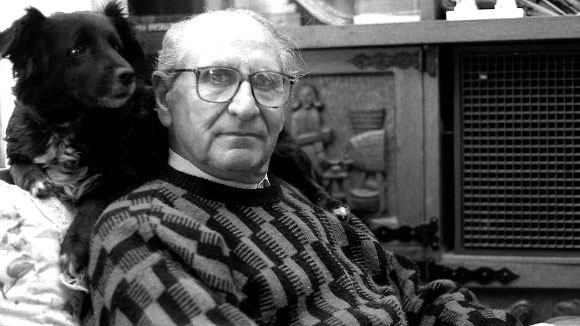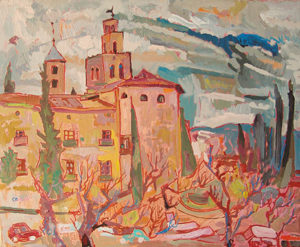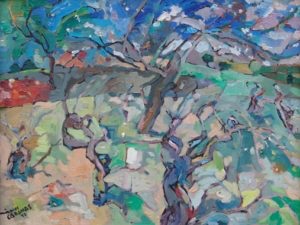BARCELONA, 1916 – SANT CUGAT DEL VALLÈS, 1995 Miquel Cabanas

He always managed to find with his brush the colors of the sky and the clouds as well as the fineness of the air that he breathed with gratitude, and that inspired his pictorial and literary poetry.
In his painting, he used nature as a constant source of inspiration, shunning sophisticated styles, and used oil techniques, varnishes and mixed pigments..
BIOGRAPHY
THE FAMILY
Miquel Cabanas Alibau was born in Barcelona, in Santos, on September 10, 1916, in the house where the grandparents and parents lived. At the age, however, of six years he moved to Sant Cugat del Vallès.
There were five brothers, and he was the smallest of the three boys: Joan, mechanic and photographer; Francisco, painter and writer – narrator and dramatist; Matilde, professor of dressmaking; Montserrat, understood in photography and poet; and Miquel, painter and poet.
His father, Frederic Cabanas and Sierra, of Sallent, was an intelligent and ingenious mechanical inventor, director and manager of a wool textile factory. Her mother, Rosa Alibau and Capdevila, of Santos, was a presser and was a great mother.
FIRST STUDIES
At the age of thirteen, in 1929, he entered as an apprentice in the painting workshop of Antoni Petit Marsal, with his name in Barcelona and Sant Cugat del Vallès, and at the age of fourteen he participated in the First Local Art Exhibition held in Sant Cugat, It had been organized by his brothers Juan and Francisco.
He attends three courses, from 1930 to 1933, at the School of Painting Masters of Barcelona and obtains the First Decoration Prize for three consecutive years. Likewise, he won a poster competition against accidents, organized by the same School and, in 1934, he won the Sant Cugat Fair and Festivals poster contest.
YOUTH
In these years of youth he combines his artistic vocation with his activity at the Colla de Bastoners, his participation as a theater actor and his affection to cycling: all these aspects are very characteristic of the cultural climate of Catalonia being reborn, where civil society has a strong push in the recovery of all aspects of the tradition and the dissemination of all new forms of sport, from the most popular (such as cycling) to the introduction of motorsport and aviation.
THE WAR
From 1934 to 1936 he is a student of the Baixas Academy and of the Llotja de Barcelona, courses that must be interrupted as a result of the outbreak of the Civil War. Fight next to the Republic and is in the front of Madrid, as some poems testify. Others also tell us that in 1939 he went into exile to France and was interned in the refugee camps of Saint-Cyprien.
BACK HOME
In 1942, he became an official at the poster and decoration workshop of Joan Queralt Oliva, in Barcelona, and in 1943 he established himself as a decorator painter in Sant Cugat del Vallès, where over the years he becomes what he says. with all the affection a citizen institution, both in his professional facet of businessman and in the exercise of his artistic and literary vocation.
CHILDREN
In 1951 he married Adelina Castells Fàbregas, a beautiful, sensitive girl, artist and peasant at heart. They will have three children: Ignacio, painter, draftsman, and director of the gallery Sala Rusiñol, in Sant Cugat; Federico, innate artist, select and great, painter and musician of vocation; and María Rosa, founder of the Niña nursery school, from Sant Cugat.
THE TEACHER
He collaborates in the founding of the Estudio de Arte group, of which he was sub-president until his merger with Amigos de Sant Cugat. In 1970 and for many years he worked as a professor of painting at the Municipal School of Fine Arts of Sant Cugat del Vallès. It is also meant workshop master, pictorial procedures technician of the Miquel Farré International School of Mural Painting, Sant Cugat, until its dissolution.
THE ENTREPRENEUR-THE ARTIST
Throughout these years, while Sant Cugat was a privileged town, Miquel Cabanas was an entrepreneur in his painting and decoration workshop: he painted kitchens, doors and walls, factories, schools, buildings of all kinds, facades, signs, license plates, pictures of bicycle with the filleted ones from before … and only in free hours he painted landscapes, still lifes, flowers: his obsession and great vocation. Seduced by the affection to poetry, at times he wrote verses of sequences of his environment, which his noble and emotional heart could not elude, nor his spirit always eager to fly so swallows.
THE CEREBRAL ACCIDENT
All this until 1974. When he was painting some signs outside his workshop, he suffered a cerebral embolism. He was transferred urgently to the San José Clinic in Barcelona. And soon his left arm and leg were paralyzed. He was subjected to a surgical intervention by Dr. Adolfo Ley Sr., eminent Canarian surgeon, and miraculously left. But with some drawbacks, turned into chronic, the eyes, and damaged the balance and the real vision of the space. From then on he is forced to make daily life with multiple limitations and unavoidable obstacles. And forced to need, for ever, the help of others.
THE HERITAGE
From this fact he was never again a wall painter. He himself spoke of his fate and explained that, thus, his gifts inherited from his parents – d ‘enginy, of artist, of feeling – could manifest as he had not been able to do before, bound by the daily obligations of work. In this situation, pushed to devise a way to perform with new and original procedures appropriate to their possibilities, he was able to continue painting pictures and writing verses.
EXHIBITIONS
In 1977 he made his first individual exhibition and he was awarded numerous prizes. Among its exhibitions include the Homage that was exhibited in the Cultural Hall of the Caja de Madrid in Barcelona, as well as those held in the Sala Rusiñol of Sant Cugat where in 1991 he dedicated the first volume of the Col collection Homages Rusiñol.
THE POETRY
In the literary field he obtains, among others, the First Honorable Mention in the Floral Games of Barcelona in 1981 and in Sant Cugat del Vallès more than once the Natural Flower, the Englantina and the Viola, as well as reached the title of Master in Gay To know. In 1990 Vilanos book publishes twelve poems, which was presented at the Rusiñol Gallery.
GRACE AND MIRACLE
This is his motto. The summary and the qualifier that applies indiscriminately to all the sincerely good and positive things of the earth. Now everything is essence. All light, color and personality. Everyone is for him and he admires and loves her. He has won many friends. And it has no enemies. And she has the sincere esteem of her children and her wonderful and hopeful grandchildren.
FALUGA AND MARILYN
It can not be ignored, because he proclaimed it, that he had every moment faithful to his side two little dogs with black hair that have even become literary and pictorial characters. The Faluga, LaMarilyn, the daughter, who was very festive, a wench with long mustaches and always disheveled, with intelligent and sensitive eyes and naughty at the same time. Their company was almost essential.
RECOGNITION
Finally, in 1994, the city awarded him Santcugatenc of the year for his human and artistic career. He died in Sant Cugat del Vallès, on May 13, 1995. That same year, The Blue Book was published. Passport to eternity. A year later the Rusiñol Gallery publishes the book 10 years of painting by Francesc Galí and Zeneida Sardà, accompanied by an exhibition that includes the painting of its last ten years. In 2005, commemorating the tenth anniversary of his death, the Sala Rusiñol organizes an Exhibition-Homage.
SUCCESSFUL SAMPLE OF THE ART OF MIQUEL CABANAS IN ITS CENTENARY
by Josep M. Cadena
In this 2016 that celebrates the centenary of the birth of Miguel Cabanas and Alibau (Barcelona, 1916 – Sant Cugat, 1995), the Rusiñol gallery, directed by Ignacio -the son of the painter- and his wife Victoria-, offers an exhibition of tribute to this remarkable artist, in what constitutes a fine display of spiritual elegance and a pertinent act of justice. Entitled El Sant Cugat by Miquel Cabanas, it includes a series of works that the plastic author, born in the Barcelona neighborhood of Sants although fully integrated in the municipality of Vallesano since he was six years old, made between 1978 and 1994 capturing the environment of a population which, fully rooted in its history, remained monumental and rural at the same time, but which was already heading towards a broad process of modernization to adapt to the great growth that Catalonia was experiencing in the last quarter of the 20th century.
Miquel Cabanas deeply esteemed Sant Cugat and always succeeded in finding with his brush the colors of the sky and the clouds as well as the fineness of the air that he breathed with gratitude, and that inspired his pictorial and literary poetry. At the same time, on occasion, he could not help but regret the speed with which the changes imposed by the citizen’s progress against the landscape of the countryside took place.
The artist was a Master poet in Gay Saber in the Floral Games of San Cugat, and are his verses, collected in The Blue Book, Passport to Eternity (1995), which best tell us how he faced the new canvas painting, by the stretched frame, / well prepared, / as plowed and marinated earth / waiting for the seed, / the canvas awaits you, painter, / your stroke of color. He painted when still Sant Cugat was a peasant village / townhouse around the Monastery. / (..) When the vines gracejo, never neglected / all polished and arrenglades, / came down from the mountain range of Collserola. And then, as now, the protagonist of the town was the monastery, a Romanesque and Gothic artistic treasure put together, / colossal architectural masterpiece, / magna and ancient heritage of a past, / a living testimony of a human desire, achieved / and excellently formed and got.
Miquel Cabanas, professor of painting at the School of Fine Arts of Sant Cugat and Master of Pictorial Procedures at the Miquel Farré International School of Mural Painting, was heavily involved in the social and cultural life of his city, which led the session he named Santcugatenc in the year 1994 -there is a bust of the artist, the work of his son Frederic Cabanas y Castells, next to the monastery-. It was a fair recognition for the one who divulged Sant Cugat to his paintings -which we can enjoy thanks to the present exhibition-, a person who wrote with full right: Our mission is fulfilled: / (..) It is already quiet, joyful, our heart . / Our work is finished! …


